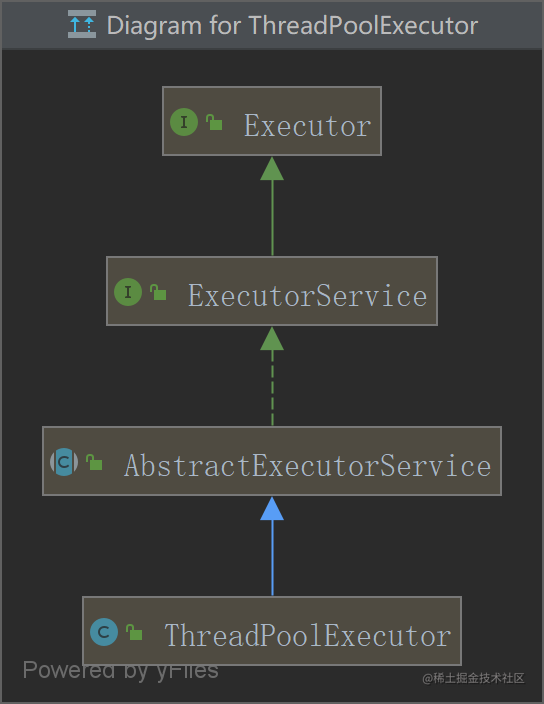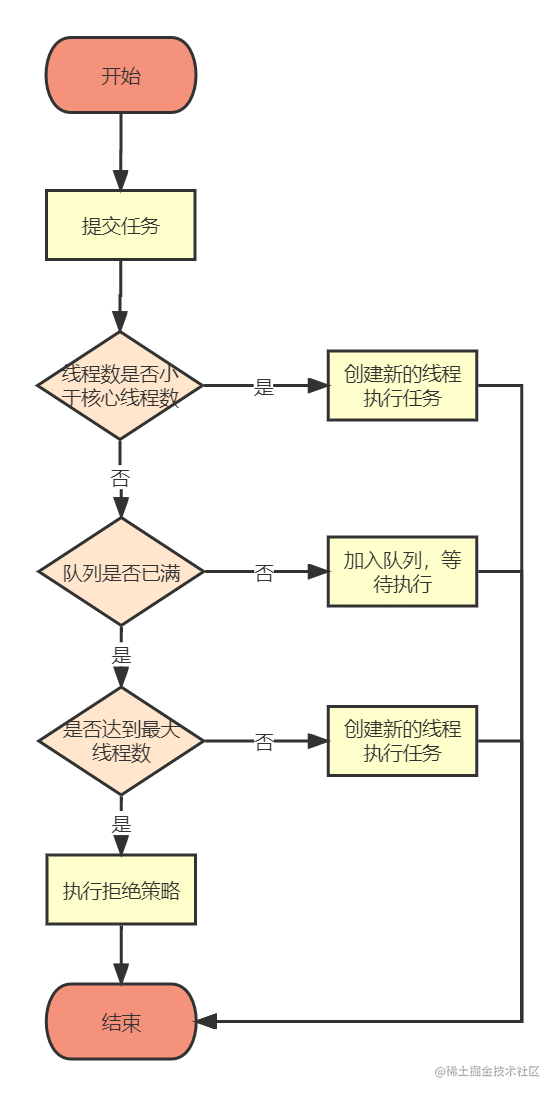Java執行緒池詳解
2023-01-31 12:00:27
一、執行緒池有哪些優點
- 減少資源開銷,不用頻繁的建立和銷燬執行緒
- 提高響應時長,有任務時可直接執行。
- 提高執行緒的可管理性,所有執行緒資源都由執行緒池統一管理。
二、執行緒池的主要引數
執行緒池ThreadPoolExecutor的繼承關係:

想知道有哪些引數,先看引數最多的建構函式:
public ThreadPoolExecutor(int corePoolSize,
int maximumPoolSize,
long keepAliveTime,
TimeUnit unit,
BlockingQueue<Runnable> workQueue,
ThreadFactory threadFactory,
RejectedExecutionHandler handler) {
if (corePoolSize < 0 ||
maximumPoolSize <= 0 ||
maximumPoolSize < corePoolSize ||
keepAliveTime < 0)
throw new IllegalArgumentException();
if (workQueue == null || threadFactory == null || handler == null)
throw new NullPointerException();
this.corePoolSize = corePoolSize;
this.maximumPoolSize = maximumPoolSize;
this.workQueue = workQueue;
this.keepAliveTime = unit.toNanos(keepAliveTime);
this.threadFactory = threadFactory;
this.handler = handler;
}
可以看到建立一個執行緒池需要七個引數。
- corePoolSize:執行緒池核心執行緒數量大小,有新任務進來時,如果執行緒池中的執行緒數小於這個值,則會建立新的執行緒來執行任務(不管有沒有空閒執行緒,都會建立),直到執行緒數量大於等於這個數量。
- maximumPoolSize:執行緒池最大執行緒數量大小(當達到核心執行緒數,且佇列任務已滿,會增加執行緒至最大執行緒數)。
- keepAliveTime:執行緒的最大空餘時間,大於這個時間將被回收(執行緒數大於核心執行緒數時,多餘的執行緒空閒時長達到這個值就會被回收)。
- unit:空餘時長的單位。
- workQueue:阻塞佇列,當核心執行緒數已滿,任務會被放到這個佇列中。
- threadFactory:執行緒工廠,執行緒池中的執行緒都是由這個執行緒工廠建立的,執行緒池提供了預設的執行緒工廠。
- handler:拒絕策略,當佇列任務已滿,且執行緒數量達到最大執行緒數,新進入的任務會執行這個拒絕策略來選擇丟棄哪個任務,執行緒池提供了四種預設的拒絕策略。
執行緒工廠ThreadFactor,執行緒池中預設給定了一個執行緒工廠DefaultThreadFactory,執行緒工廠的作用是用於建立執行緒,自己建立執行緒工廠時需要實現ThreadFactor介面,該介面中只有一個方法Thread newThread(Runnable r);,即建立執行緒的方法,自定義執行緒工廠的好處是可以自定義執行緒名稱。
阻塞佇列BlockingQueue,阻塞佇列是在核心執行緒滿了以後存放任務使用,常用的有LinkedBlockingQueue、ArrayBlockingQueue、SynchronousQueue、DelayedWorkQueue等,當阻塞佇列也滿時,會建立執行緒至最大執行緒數,如果佇列已滿,也達到最大執行緒數,則執行拒絕策略。
拒絕策略RejectedExecutionHandler:
- DiscardPolicy:丟棄該任務,不拋異常。
- DiscardOldestPolicy:丟棄最早加入佇列的任務,不拋異常。
- AbortPolicy:丟棄該任務並丟擲異常
RejectedExecutionException,預設使用該策略。 - CallerRunsPolicy:由呼叫執行緒池的執行緒來執行當前任務。
檢視原始碼:
public static class DiscardPolicy implements RejectedExecutionHandler {
public DiscardPolicy() { }
public void rejectedExecution(Runnable r, ThreadPoolExecutor e) {
}
}
public static class DiscardOldestPolicy implements RejectedExecutionHandler {
public DiscardOldestPolicy() { }
public void rejectedExecution(Runnable r, ThreadPoolExecutor e) {
if (!e.isShutdown()) {
e.getQueue().poll();
e.execute(r);
}
}
}
public static class AbortPolicy implements RejectedExecutionHandler {
public AbortPolicy() { }
public void rejectedExecution(Runnable r, ThreadPoolExecutor e) {
throw new RejectedExecutionException("Task " + r.toString() +
" rejected from " +
e.toString());
}
}
public static class CallerRunsPolicy implements RejectedExecutionHandler {
public CallerRunsPolicy() { }
public void rejectedExecution(Runnable r, ThreadPoolExecutor e) {
if (!e.isShutdown()) {
r.run();
}
}
}
如果想要實現自己的拒絕策略,那麼實現RejectedExecutionHandler介面即可。
三、執行緒池的執行流程
如下圖:

五、Java提供的快速建立的執行緒池
Executors提供了幾種快速建立的執行緒池:
- newSingleThreadExecutor,只有一個執行緒的執行緒池
public static ExecutorService newSingleThreadExecutor() {
return new FinalizableDelegatedExecutorService
(new ThreadPoolExecutor(1, 1,
0L, TimeUnit.MILLISECONDS,
new LinkedBlockingQueue<Runnable>()));
}
- newFixedThreadPool,固定執行緒數量的執行緒池
public static ExecutorService newFixedThreadPool(int nThreads) {
return new ThreadPoolExecutor(nThreads, nThreads,
0L, TimeUnit.MILLISECONDS,
new LinkedBlockingQueue<Runnable>());
}
- newCachedThreadPool,可快取的執行緒池,即不限制執行緒數量的執行緒池。
public static ExecutorService newCachedThreadPool() {
return new ThreadPoolExecutor(0, Integer.MAX_VALUE,
60L, TimeUnit.SECONDS,
new SynchronousQueue<Runnable>());
}
- newScheduledThreadPool,定時執行緒池,可週期性或延遲執行任務的執行緒池(使用延時佇列)。
public static ScheduledExecutorService newScheduledThreadPool(int corePoolSize) {
return new ScheduledThreadPoolExecutor(corePoolSize);
}
public ScheduledThreadPoolExecutor(int corePoolSize) {
super(corePoolSize, Integer.MAX_VALUE, 0, NANOSECONDS,
new DelayedWorkQueue());
}
- newSingleThreadScheduledExecutor,單個執行緒的定時執行緒池,功能和上面一樣。
public static ScheduledExecutorService newSingleThreadScheduledExecutor() {
return new DelegatedScheduledExecutorService
(new ScheduledThreadPoolExecutor(1));
}
六、最後
歡迎關注個人微信公眾號
